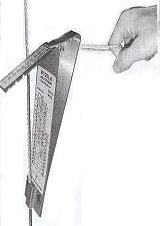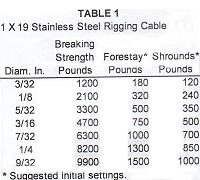Using a Loos Gauge to tune shrouds on a Catalina 22
|
I bought an almost new 2007 Catalina 22 in 2008. It had been sailed only once. Most items were still new in the plastic wrappers. I have sailed it now more than 2500 miles in some fairly stiff breezes at times, stiff enough that I had to reef in the 150% roller furling jib as much as 80% at times to keep things under control. I have read that while stainless cable doesn't stretch exactly, new cables under load will pull the twisted strands of wire tighter with the corresponding effect of allowing the cable to lengthen itself by a percent or two. It is important to keep your mast shrouds tuned. This will provide a better sailing experience and prevent premature failure of cables, mast, chain plates, fittings and so on. If the leeward shrouds are too loose under load and your boom swings across quickly in a fast tack or gybe, the snap this produces on your shrouds is not good for the boat. Besides seeing a sailboat cruising along on a heel with the fenders out, there is nothing much uglier in the sailing world than seeing the leeward shrouds waving back and forth in the breeze.
First of all you need to know what kind of stainless cable you have... a common type particularly for blue water boats is 302/304 stainless. This is a bit stronger for the same diameter of 316 stainless, but many builders today, like Catalina, use 316 stainless for boats like the 22 as 316 will resist corrosion better than 302/304. Consult your manual, your manufacturer specs, or forums to determine what kind of shrouds you have. You can buy an inexpensive thickness gauge to determine whether it is 3/32 - 5/32" for which you want the Standard Model Loos Gauge... or whether it is larger which requires a heavier (and more expensive) model. |
|
My 2007 Catalina 22 Mk II came fitted from the factory with 1/8" 1x19 316 Stainless shrouds. Knowing this, I bought a Standard Model Loos Gauge. The newer ones also have a little cable diameter gauge at one end so you can accurately measure your cable thickness. You can take your best guess, use a micrometer or another way to measure the diameter of your cable, buy the appropriate Loos Gauge and most likely be able to exchange it if you guessed wrong in order to buy a larger one if needed. You can buy them on amazon.com.
So now you are ready to measure the tension on your shrouds. As shown in their instructions, you clip the the bottom of the gauge onto the shroud and gently pull back on the little cord loop stretch the indicator to the dark black line which is indicated with an arrow "Pull to this mark." Be careful not to overstretch the gauge as you could bend it out of shape and ruin it. Then you read the corresponding number which lines up with the middle of your shroud. The correct number for the Catalina 22 shrouds is between 29 and 31 which correspond to 250 - 280 lbs of tension, about 15% +/- of the 1785 pound breaking strength. You get these numbers from the chart on the back of the gauge. Another item you want to look at is to make sure your mast is "in column". That is, make sure it is straight. To do this stand next to it, put your eye right against the slot at the back of the mast and sight up the slot to the top. It should be straight. You may be shocked as to how much it may bend either to port or starboard. I sure was. Oops! So to correct any curve in the mast, you start with the main shrouds, the ones that pass through the spreaders all the way to the top of the mast, see what your current tensions are and if ball park, then tighten one while loosening the other to get it straight. You should remove any cotter pins or rings from the turnbuckles at the bottom of the shroud or loosen the locknuts if fitted with those. My Catalina 22 loosens tension when turning the turnbuckle clockwise and tightens it when turning counterclockwise. You should use a wrench on the swaged fitting at the top of the turnbuckle to keep the cable from twisting as you tighten or loosen your shrouds. Take a few turns on each and then sight up the mast again... it may take a number of tries to get it straight. Now recheck your tension again with the Loss Gauge, adjust one or the other to make sure they are the same, be sure the mast is still straight, and then loosen or tighten each side one half turn at a time until you have the proper tension on both main shrouds. Somewhere around 30 is pretty good for my Catalina 22. NOTE: Depending on how many turns you need to make on the swaged fitting with the wrench, it may be a good idea to remove the pin which connects the shroud to the deck of the boat next time you unstep the mast and allow the cable to untwist itself. It may be necessary to recheck your tensions next time you step the mast if it was twisted too many times. Next you should check the tension on your forestay with the back stay loose if you have one. If you have a furling jib, like my Cat 22, then you can only adjust the backstay to tension your forestay. According to Loos, it should carry about 1/3 more tension than your shrouds. Again this may vary with your boat. You need enough tension to prevent two much sag in your forestay when your jib is under load. some sag is unavoidable, but less sag translates to better pointing ability. If you have to change your forestay and/or backstay much to get them tensioned properly then you will need to recheck your main shrouds and probably readjust them up or down again to get them within specs. Now it is time to tackle your lower shrouds, the ones that go up to the point where the spreaders connect to the mast. My Catalina 22 has two... one forward of the main shroud and one aft. Common theory has it that you should have slightly more tension on the forward lower shrouds than the aft lower shrouds. The reason is you want to get a slight bow to the mast towards the bow which will straighten out slightly under heavy load on the jib. You do NOT want the reverse bow because heavy load on the jib could bend your mast too much and crack it. I set mine at 31 for the forward lower shrouds and 29 for the aft ones. This is a good starting point, I think... and detailed oriented sailors may want to read up further on advanced tuning techniques and vary these numbers a bit to achieve a more performance oriented tune to the mast and rigging. I hope this has been a useful tutorial. I really could not find any good comprehensive overview of this process anywhere so I decided to create my own web page for it and let Google do the rest to help other folks whip their own rigs into shape.
Good luck and happy sailing!
|
 There is much written about tensioning the shrouds and some sailors have devised all sorts of clever and complicated ways to do it, but for around a hundred bucks you should seriously consider investing in a Loos Wire Tension Gauge. This is an inexpensive yet accurate method of checking shroud cable tension. There are several different sizes depending on the size cable your boat comes with. Since this article is about tuning the shrouds on a Catalina 22, I still stick to the specs for that boat, but it is a simple matter to vary the numbers according to shroud size.
There is much written about tensioning the shrouds and some sailors have devised all sorts of clever and complicated ways to do it, but for around a hundred bucks you should seriously consider investing in a Loos Wire Tension Gauge. This is an inexpensive yet accurate method of checking shroud cable tension. There are several different sizes depending on the size cable your boat comes with. Since this article is about tuning the shrouds on a Catalina 22, I still stick to the specs for that boat, but it is a simple matter to vary the numbers according to shroud size.
